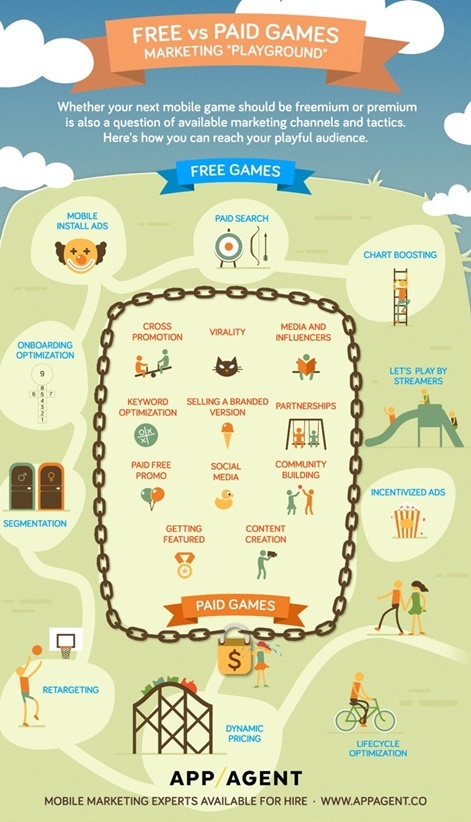Peter Fodor is the founder of AppAgent, a service for small and mid-sized mobile developers who are launching a game or app but need help with marketing and user acquisition.
Deciding whether your newest mobile game should adopt a freemium or premium business model is one of the most important decisions a developer can make.
It will not only define the way you generate revenue, but will also influence your choice of marketing channels and tactics.
To help you make the best decision for you and your app, we’ve summarised how you can reach your audience with both business models in a playful infographic (which you can see below).
If you’re considering which approach to take to market, it’s worth taking the time to understand the difference in marketing freemium and premium mobile games. So, let’s begin.
More fun with freemium?
It’s clear that free-to-play games offer a much wider range of marketing activities.
But why is that? It’s because marketing isn’t focusing only at making a great impression of the game “on the shelf”.
With a game-as-a-service model, the business relies on engagement and conversion to payers.
To illustrate this, it’s useful to use the famous AARRR conversion metric developed by Dave McClure, founder of 500 Startups
You can see that we’ve adjusted this slightly to make it more relevant to the mobile space, but the principles are still the same.

At every step in the process mobile marketers are able to utilise various tools and tactics that will lead the user to the next stage. The aim is to ultimately reach a lifetime value that’s higher than acquisition cost.
Dark times for paid games
Earlier this year I hosted a panel discussion at Game Developers Session 2016 where we covered the possibilities for the promotion and monetisation of paid games.
Compared to freemium models, it’s actually fairly difficult to attract a large audience to paid games, especially on Android.
It’s no secret to anyone in the industry that Google rarely supports paid games by featuring them.
It’s vital to think about the business model you want to follow as soon as possible in the development cycle.
Even on the App Store, where Apple supports lots of paid games, only 21% of all titles have a price tag. Of these 89% are priced at $3 or less, which is quite shocking to me.
The first paid game in the top grossing charts (to be accurate, it’s a paymium title combining upfront payment and in-app purchases) is NBA 2K17 by the publisher 2K. It is at number 182 in the charts.
That means that the top 181 highest revenue App Store games are all freemium!
Decide your path early on
As a business, it’s vital to think about the business model you want to follow as soon as possible in the development cycle.
Choosing between paid, free with ads or freemium defines not only the product, but by a large portion, your marketing strategy and your options for generating revenues.
Jan Ilavsky, Apple Design Award winner with the game Chameleon Run, recommends paid games to individuals, small teams and people who: “basically don’t care about money”. As a fulltime indie developer he makes enough of a living with paid games.

If you have a small to mid-sized company paid games become much more tricky.
London-based studio Ustwo, the team behind a mega hit Monument Valley, invested $1.4 million into the development of the game.
It took the team 55 weeks to finish the original game and another 29 weeks for the DLC Forgotten Shores with eight core team members. With massive support from Apple, Google and Amazon revenues got close to $6 million in its first year, which is over 4x of the costs.
Within two years, the title had made $14.4 million.
But Marek Rabas, CEO of Madfinger Games, doesn’t consider Monument Valley as a success.
“The team went on a very risky path where a smaller support by platform owners could easily result in a big financial loss,” he said at the Game Developers Session in Prague.

My personal suggestion is to experiment with free games supported by ads, as these are still fresh and provide less intrusive ways to integrate rewarded videos in the core game loop.
It could be by doubling coins, offering an additional life after failing a level, or allowing a free spin of the lucky wheel for example.
As a developer you can reach a larger audience and build a good foundation for an upcoming title using cross-promotion. It’s also easier to make a viral hit with a free game supported by ads without the complexity of freemium economics.
Feel free to get inspired by our infographics and explore what works the best for you.
Paid games
- Cross-promotion
- Focus is on virality
- Media and influencers
- Keyword optimisation
- Selling a branded version
- Partnerships (such as Starbucks Pick of the Week)
- Paid free promo
- Social media & forums
- Community building
- Getting featured in the store
- Video content creation
- A/B testing of store assets
- Referrals
Free games (F2P games / games as a service)
All from paid plus…
- Paid search
- Mobile install ads
- Chart boosting
- Reviews and let’s play by streamers
- Onboarding optimisation
- Using rewarded videos to upsell premium features
- Balancing monetisation
- Segmentation and personalisation
- Dynamic difficulty and monetisation
- Lifecycle optimisation
- Retargeting
























